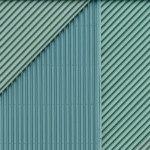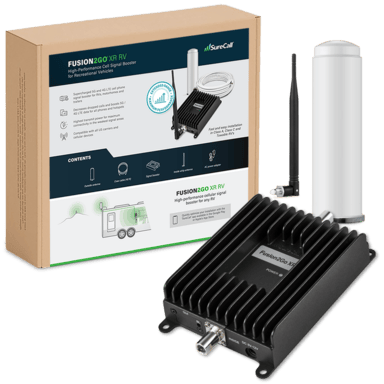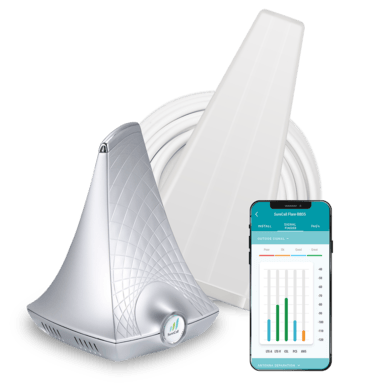
What Can Block My Cell Phone Signal?
Posted by Dennis Findley on 7th Sep 2017
Building materials, organic factors, cell tower location, cell tower capacity and a variety of other factors can have a negative impact on your cell phone signal.
So, you’ve got bad cell reception and your Fitbit numbers are climbing from baby-stepping around the building to get a better connection?
More than likely walking outside right now is your best bet for tapping into a clearer and stronger cell phone signal. There are real reasons for this. Building materials, particularly the materials that stand in the way of you and that clear cellular signal you need.
Cell phone carriers tend to be the scapegoats in these situations when the likely culprits are the materials and objects around you. Below is a list of things that interfere with cell phone signals for you to remember next time you are unable to make or receive a call, text, or access other cellular data.
4 Common Things that Interfere with Cell Phone Signals
1. Building Materials
- Construction materials can be divided into non-conductive materials, which modestly impact your cell reception, and conductive materials, which have a much more significant impact. Conductive materials are most often electricity-conducting materials like tin, copper, silver, aluminum, and others that can absorb or completely block a cell signal. Non-conductive materials such as wood, drywall, plastics, glass, and others can reduce a cell phone signal but, in most cases, will not completely block a strong signal.
2. Organic Factors
- Mountains, hills, snow mounds, trees, water, corn fields, and other similar land and organic features can block or reduce cell signals. Each range in impact. For example, fresh water may reduce your signal whereas salt water will completely block it and a tree with no leaves may give you a clear connection whereas in spring, a tree full of leaves will reduce your signal. Keep in mind that the changes in seasons can have a huge impact on your cellular signal.
3. Cell Tower Location and Direction
- Cell phone reception is a frequency or wave. When you think of a wave or ripple in a lake traveling a long distance, eventually the wave will diminish completely. This rings true for radio frequency (RF) signals also. The further you are from a cell tower, the less strength that signal will have. Additionally, you could be positioned right next to a cell tower and receive no connection (Related Post: AT&T Coverage Map). This is because the cell tower could be directing that signal right past you.
4. Cell Tower User Capacity
- Think about concerts, festivals, sporting events, and other high-cell-user-concentration venues. A cell signal source has limitations on the number of users it can accommodate. This is why you may have trouble sharing a video or picture or making a call when you’re watching The Rolling Stones live at Desert Trip with 80,000 of your closest friends. On top of bandwidth limitations, humans, much like organic material, are filled with water and can absorb RF waves. Stack a line of humans between your cell connection source and your phone and you’ll be left with little to no cell signal.
3 Less-Common Things that Interfere with Cell Phone Signals
1. Weather
- Earlier we mentioned that water can reduce your cell signal. Well, it can do that in each of its different forms. Fog, snow, rain, sleet, hail; these will all have an impact on your signal. On top of that, dusty air from strong wind, can also have a weakening effect on your cell phone signal. In fact, the air itself creates something called free-space path loss which severely diminishes cell phone signal strength.
2. Transportation
- Cars, busses, trains, planes, and others are most often built with a conductive metal shell. With many car manufacturers developing their newer car models with lighter, stronger aluminum frames, the reception limitations will only continue to grow.
3. Radio Frequency (RF) Interference
- In the 21st century all of our devices are in constant communication with other people and devices. Bluetooth devices, Wi-Fi signals, microwaves, AM and FM radios, GPS devices, and a whole slew of smart devices all use RF waves to get the job done and can have an impact on your reception if you’re surrounded by too many of them.
How to Prevent Your Cell Phone Signal from Being Blocked
To sum things up, each of these inhibitors work in combination with each other. For example, one sheet of drywall will block some reception whereas ten sheets of drywall may block all reception.
This being the case, we suggest taking a combined approach to creating a space with good cellular reception. The best practice would be to use a cell tower locator app to place your antenna(e) in the best location on your property and, if you have reception outside of your building, use a cell signal booster and point the outdoor antenna at the tower and place the indoor antenna in your most used area of the house.
Here is a great post where you can learn about all of your options for improving cell phone reception.
Fusion2Go XR RV Cell Phone Signal Booster
Fusion4Home Yagi Panel Indoor Signal Booster



